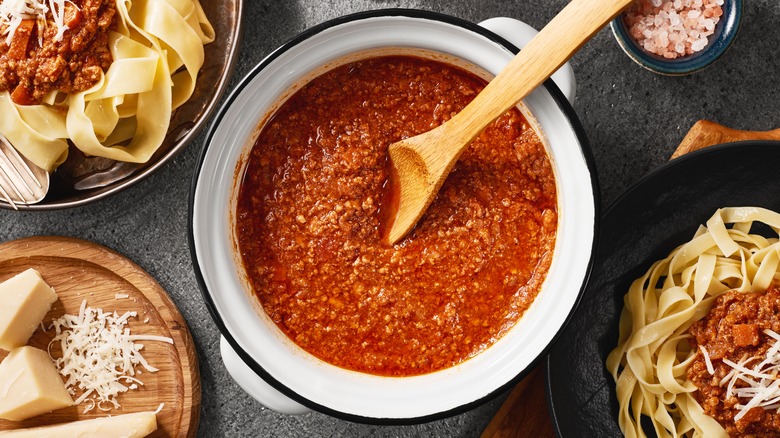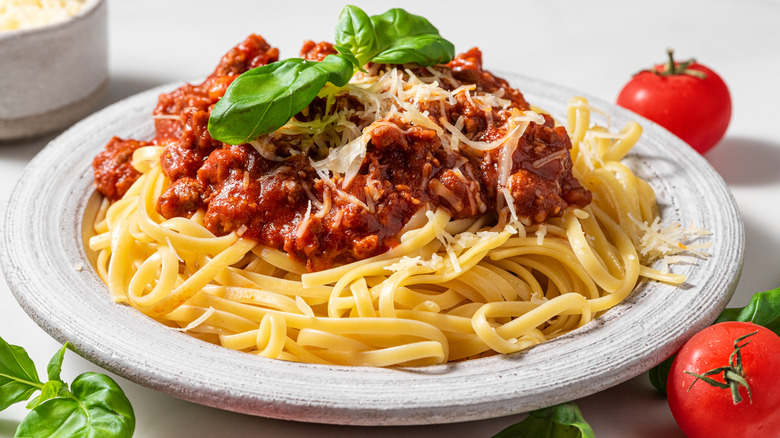Why Ina Garten Ditches The Spaghetti For Bolognese
Spaghetti bolognese has become a favorite family meal for many households. But you won't find the dish on dinner tables or in restaurants (except sometimes in those specifically aimed at tourists) in Italy. That's because while ragu alla bolognese is a traditional dish named after Bologna in Northern Italy, the slow-cooked meat-based sauce is never traditionally served with spaghetti.
Made from ground meat and tomatoes, ragu is a broad Italian term for sauce, which can refer to a number of variations. But ragu alla bolognese is a much more specific dish. The Italian Academy of Cuisine published an official recipe back in 1982 that contains several rules about which ingredients are permitted in the sauce; it contains an optional bit of milk, for example, but no smoked pancetta, garlic, or herbs.
Ina Garten also steers clear of spaghetti for her weeknight pasta bolognese recipe. Instead, the Barefoot Contessa opts for orecchiette, a small, round pasta shape that translates as "little ears." The reason? The bowl shape catches and holds the meaty sauce well. While this is also not traditional — most Italians would rather choose tagliatelle as the accompaniment for bolognese sauce — there are several reasons why this pasta shape, as well as several others, works better than spaghetti.
The best pasta shapes to pair with meaty bolognese sauce
Deciding which pasta shape to pair with which sauce is not a random choice for Italians – which is perhaps not surprising for a country that boasts over 500 pasta shapes. Tagliatelle is traditionally used for ragu alla bolognese in Italy, but other pasta shapes can also be a match for the heavy sauce, with tortellini or gnocchi sometimes being served with the meat ragu.
Ina Garten uses orecchiette pasta for her bolognese sauce because she finds that the shape of the little shells holds the meaty sauce well. And shapes such as shells or rigatoni tubes do contain the meaty sauce effectively — while the ragu is also hugely popular baked between pasta sheets in a traditional or even vegetable-heavy lasagna recipe.
In Italy, spaghetti itself is reserved for light buttery or oil-based sauces, or creamy sauces such as carbonara, as well as seafood sauces. But other long pasta ribbons, such as the flat wide noodle pappardelle, are commonly used for bolognese-style ragu sauces, with the dish being known as pappardelle al ragu.
Spaghetti Bolognese is a classic — but it's not Italian
In 2019, the Mayor of Bologna launched a campaign to disassociate spaghetti bolognese from the city, calling the dish "fake news" (via Business Insider.) But if asking for "spaghetti bolognese" is a foodie faux pas in Italy, then how come it's such a popular and well-known dish around the world?
Pairing meaty ragu sauce with pasta dates back to the late 18th century. In 1891, Pellegrino Artusi included a recipe for bolognese macaroni in the book "Science in the Kitchen and the Art of Eating Well." Then in the early 20th century, tagliatelle came to be used as the pasta of choice in Italy. Around that time, however, Italians emigrating to the United States brought the recipe with them — but paired the sauce with spaghetti, which was more widely available than tagliatelle.
In 1917, Julia Lovejoy Cuniberti recommended serving macaroni or spaghetti with the meat sauce in the cookery book "Practical Italian Recipes for American Kitchens." After that, spaghetti bolognese became so popular that many people continue to think of it as a traditional Italian dish; though Ina Garten — while her recipe is still not traditional with its use of garlic, herbs, and cream — matches a more appropriate shape of pasta for the meaty sauce.



